|
|
Review of GSM-smartphone Nokia 5500
Nokia 5500 live
photos >>>
Description
of standard applications for Smartphone >>>
Browser description
>>>
Standard kit:
- Handset
- Battery BL-5B 860 mAh Li-Ion
- Charger AC-3
- Sport stereo-headset HS-29
- 64 Ìá MicroSD memory card
- CD-ROM with PC Suite and Nokia Sport Manager Software
- User’s Guide
- USB-cableCA-53
- Wrist band CP-135
- Clip and carrying bag, CR-64
Established high market segmentation, and constant attempts of
manufacturers aimed at making up new niches have brought up to life
a couple of cutting-edge projects. Particularly one of them is springing
up before your eyes – so called sport-centric handsets, designed
specially for people going in for sports. The first sign of this
infant line-up is Nokia’s very own the 5500, which can be considered
as a pioneer of the field not only in terms of feature set, but
its announcement time.

To cut a long story short, all devices having knack for the sports
are equipped with somewhat different casing, featuring splash resistance,
media capabilities, built-in pedometer and other functions which
may come in handy in course of exercising. The most elementary form
of pedometer is a 3D-sensor detecting number of steps made. For
instance is Samsung E750/E760 similar technology is applied to managing
media player and several games, yet in sports it finds no application.
If you turn the review of these handsets you will see us complaining
about absence of steps counter – in fact that capability would have
increased overall utility of the devices. But the chance missed
by the Korean engineers was taken advantage of in Finland. However
the truth is a couple of years ago we spotted Pantech introducing
a phone with pedometer at CeBIT – in Asia these solutions even if
not widely adopted, are at least well-recognized, while the Europeans
were experiencing lack of these gadgets until now.
Sport-centric models have direct connection with a class of outdoor
phones. These handsets have been known for quite a while and appeared
in the first place as solutions for kind of people working in the
open air in adverse environment. I remember my first stunning impression
of a commercial starring Nokia 6250 where a doctor walked on dirty
and worn out road in the rain, and the phone remained ok. In other
words at that moment such devices were targeted at certain groups
of consumers, where they were little success due to both pricing
and physical aspects – where can you see a roadman showing off a
phone at the cost of 400-500 USD?! The workers themselves could
not found those among them as well, actually.
But these handsets did their own part and revealed certain interest
in similar solutions, thus the manufacturers started developing
a platform which would appeal to the mass market. Siemens M35 with
its semi-proof casing proved to be a decent phone, since it featured
acceptable price combined with the same set of functions as that
found on Siemens C35. Siemens deserves a special credit; in light
of the fact only owing to its efforts the market of Outdoor phones
proposes wide model range. As a matter of fact on entering the market
this company was looking for some free niches to fill, and therefore
managed to start up a completely new trend in this field. In its
turn, Nokia came up with its own protected models in reaction to
corresponding developments by its major competitor back then, Ericsson.
As these plans of Ericsson were slipping away, Nokia consistently
canceled its activity as well, but eventually didn’t abandon this
offshoot.
In 5000 series, retaining all signs of youth handsets, there were
some splash-proof models up to now, namely Nokia 5210, Nokia 5140,
Nokia 5140i. All these devices were promoted as extremely durable
models with sporty capabilities, like Fitness Coach, Sport Diary
and various additional accessories. Nevertheless in view of price
at some sorts of extra gadgets and lack of advertising, these offsprings
of the sport class were not much of hits.

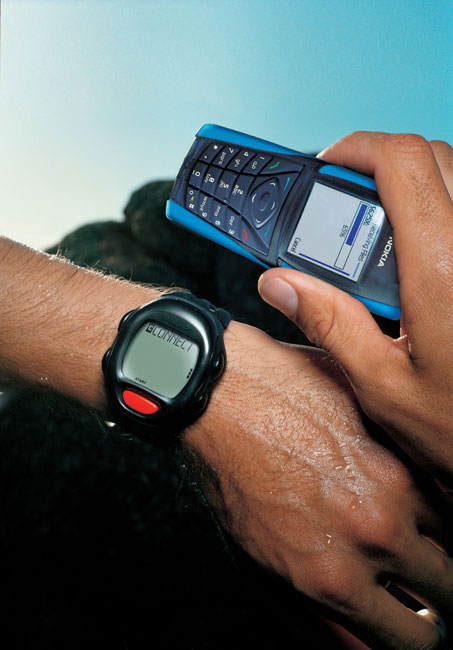
Nokia 5500 adopts both rich sport-centric functions and proof casing,
but the sporty applications bear the palm – in fact it’s emphasized
in the index itself, which is unusual for Nokia (Nokia 5500 Sport).
Nonetheless uniqueness and highlighting of the phone are not only
that – this model is also the first handset to incorporate smartphone’s
capability into a proof casing.
Design, casing and keypad
The design found here is markedly youth, but by no means defiant.
What really make it look youth-aimed is display’s edging, turning
into pick/hang up keys. The frame’s color is striking only on titanic
finishing (we are talking about trim, not the material used) – on
black it’s painted into white and perfectly matches the outlook.
Apart from aesthetic purposes, the edging protects the screen so
that one can simply put it face-down without worrying for scratching
or somehow damaging it.



The handset comes in two colors – titan with yellow framings and
black with white ones. The first trim will look more appealing to
youth or more active part of older people. The other finishing is
not so flashy and thus will fit in office environment. Widening
trim pool works fine and widens target audience – I suppose this
handset will be bought primarily by men from 18 to 40 (as for the
second color scheme – from 25 to 40), women will occupy nearly 20
percent of the audience, which is uncommon for a product of such
type. This affinity originates from the fact that these are women
who continue having a run every morning and badly need a gadget
for counting distance covered and calories burnt.

The casing’s protection isn’t just a marketing trick – it really
fulfills its part and is almost alike that of Siemens’s best solutions
residing in Outdoor class. Firstly, the handset itself is entirely
made of metal, while the sides feature rubber as the main material
used and the rear panel is composed of thick plastic layer. The
battery cover is fastened with a screw. In view of all pros, there
is a minor draw about the design – the interface connector’s hood
(made of soft rubber) comes loose after a short period of usage
and on top of that there is no way to remove it.




While made of rubber, the keypad is solid and don’t have any obvious
flaws – the buttons are somewhat soft with good click sensation.
The keypad is lit in bright white, and thus visible in various environments.
The navigation block, measuring very little in size may cause certain
inconvenience especially with pressing the OK key incorporated into
the navi-pad. Personally I didn’t spent much time on getting used
to the buttons without experiencing issues, one more thigh of note
is that accidental presses are so rare that you can forget about
key lock. Having checked out photos on the net, some users have
expresses worries about size of pick/hang up buttons, though I assure
you they are big enough to fit any finger.
Video,
keypad and battery cover (wmv, 10.1 Mb)>>>


Many have been at a loss where the correction key (pencil) is gone
to, since Nokia 5500 is a smartphone and that key should be somewhere
on the casing. Over limited space available on the front, the developers
relocated it to the right side a bit lower its normal position.
When working single handedly such mounting is not quite convenient,
as you have to use your second hand to do corrections.






Infrared port, as well as function key for switching between player,
sport and standby modes, can be found on the right side as well.
The left side holds rocker volume key and Push To Talk dedicated
button. Using the power button on the top rim, you can not only
start up or shut down the phone, but also perform fast profiles
switch. Just right here you will find a flashlight, basically it’s
a separate LED, getting activated by pressing * key.
Video,
flashlight and key for switching (wmv, 5.16 Mb)>>>


The rear feauter a 2 Mpix CMOS camera module, similar to those
embedded in other smartphones of the company (no auto-focus and
flash).

And now hang tight, because we are publishing dimensions and weight
of this all-round protected device. So, It weights 103 grams, which
is quite normal for a smarphone, while its measurements of 107õ45õ18
mm make the 5500 the smallest S60-powered powered device nowadays.
It’s size which makes all the difference here – until today all
smartphones were considerable bigger than standard phones, but Nokia
5500 breaks this tendency and obviously demonstrates possibility
of an opposite. In future we are to see more smart handsets making
use of compact casings – against that background Nokia 5500, Nokia
E50, Nokia N73 seem to be only the first signs.
Video,
comparing it with Sony Ericsson K790i è Nokia N80 (wmv, 6.99 Mb)>>>




Screen, battery, memory, CPU, Bluetooth, USB
The handset carries a 208õ208 pixels (31õ31 mm) display capable
of reflecting up to 262 K colors (TFT) – implementation of such
screen results from considerably small dimensions and safety requirements
(it’s widely known that display is the most fragile and unprotected
part of any phone). Nevertheless it performs quite well and boasts
fair color rendering and image sharpness, but if it comes to comparing
the 5500’s screen with handsets by Samsung, Motorola, Sony Ericsson
residing in the same price bracket, it would not be able to withstand.
On the other hand we should set it off against smartphones – and
if that’s the case, Nokia 5500 is way ahead.
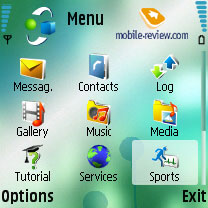
Thanks to low screen resolution (relatively low!) it retains only
3x3 main menu grid therefore you’ll have to turn to scrolling pretty
often; the icons themselves are good in quality-wise.
Moderate size of the casing didn’t let them to include better battery
and thus the handset operates only with 860 mAh capable BL-5B. As
the manufacturer claims it remains good from 2 to 4 hours of talk
time and for 150-270 hours in standby mode. In conditions of Moscow
networks the charge lasted for one day on average, at 1 hour of
media player usage (radio of player), up to 45 minutes of calls
and nearly 20 minutes of web-browsing. By the end of the day the
charge was falling down it the very bottom and we had to recharge
the phone. Though it’s worth saying that all smartphones based off
S60 3td Edition consume pretty much and this model isn’t an exception.
Some not demanding users may be able to squeeze almost 2 days of
life time, but for the majority of audience everyday recharging
is inevitable, on top of that recharging in course of the day may
prove useful as well. On the whole the life time is the only critical
flaw of this model, all other specs are great.
The bundled memory is may be expanded using microSD cards, which
are plugged in a slot located under the battery – evidently there
is no hot swap as it should be in a truly protected phone.


The model runs the same platform as other smartphones of the company
– the CPU works at the frequency of 220 Mhz, while amount of RAM
reserved for applications equals 32 Mb, thus nearly 10 Mb of internal
memory are at user’s disposal, yet it’s not a big deal since all
data may be stored on the memory card.
The Bluetooth 2.0 connectivity features supports EDR as well as
the following profiles:
- BIP-ImagePush;
- DUN-GW;
- FT-Server;
- HandsFree-AG (1.0);
- Headset-AG;
- OBEX;
- OPP-Client;
- OPP-Server;
- SIM Access-Server.
Unfortunately A2DP profile standing for transmitting sound to wireless
headset is not on board here. On the other hand, in light of the
device featuring pedometer, I doubt someone would put somewhere
else but on his body when exercising (otherwise what’s the point
of buying it?), so necessity of a wireless headset is unclear.
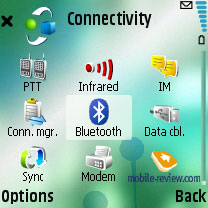
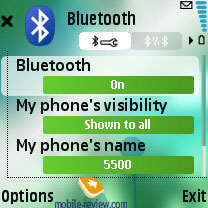
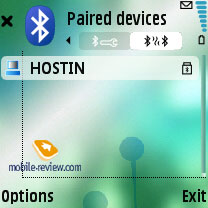
On USB connection the handset requires you to check one of the
following options defining which mode you would like to use: Data
Transfer, Media Player, PC Suite. In many ways the handset shares
many of Nokia 3250 capabilities by being able to get tunes via Windows
Media Player (curious fact – only the N91 features Microsoft’s Janus
DRM support, while neither this nor any other device does). The
phone also takes advantage of USB 2.0 and USB Mass Storage.
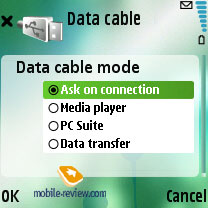
Of troublesome aspects, common for this platform, I should note
the following one: when synchronizing messages with a desktop, data
transfer mode does not get activated until you select memory card
as main storage type. Although this approach is justified in 100
percent of cases due to minor built-in storage size, the system
has several annoying bugs. Switching destination place without copying
data from the mail box allows activating data transfer. However
there is one serious “but” in all this – in this mode all mail boxes
tied to the memory card become invisible and appear again only when
memory type is changed. Such way of moving data puts into question
full-fledged usage of all handset’s functions at the same time.
Sport mode
The built-in 3D sensor makes it real for the Sport mode to exist
in this model. Observation accuracy is just enough for most cases,
yet similarly to other phones with a pedometer on board, there is
a certain measure of error possible, including random start ups
when driving in a car (it’s a drawback of all sport-centric devices).
But for routine trainings the 5500 provides more than satisfactory
accuracy.
The key found on the right side allows starting up the sport mode
– this key also stands for switching between player, sport and standby
modes (or the last launched application). The button is very handy
in use – it would really nice to see something of this kind on other
phones by Nokia as well. While in standby mode the navi-pad is lit
in while, but once Sport mode has been started up it turns into
red. Such visual alterations are essential when running – there
you don’t have time to cast a glance at the screen. A very fetching
peculiarity.
The main menu of Sports mode holds three icons, which are: Quick
Start, Diary and Tests. Let us reverse the order and start from
the end, namely from Tests. There are two tests available on the
phone – cooper and bike test hard. In the first case you’re offered
to run a certain distance in set time and then compare the acquired
result with special table to clearly see you optional goals. The
test itself is meant to determine your physical state. So all you
need to do so is to find a stadium where you can precisely evaluate
the distance. One more thing of note – the handset does not provide
individual adjustment, in other words you cannot set the functions
according to you liking as on Sony Ericsson W710i.
Video,
sport mode (wmv, 8.48 Mb)>>>
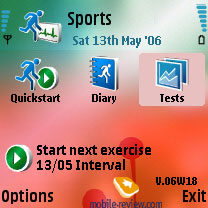
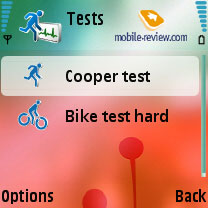
To go through a bike test hard you are going to need an exercise
bicycle, where you can see both load and pulse, but many are more
likely to find this test useless.
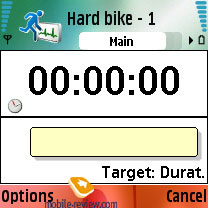
And finally, if you choose Quick start, you can start measuring
right away – on the home screen you will distance covered (0.0 km),
calories burnt and total duration of you exercise. There are several
tabs available showing duration only and pedometer’s data only.
There you will find average speed, amount of steps made and spent
energy. Here you may not set up anything and proceed to exercising
right away – the application works fine in background for the whole
day or even several days. After the counters have been initialized,
you can start marking Laps – this parameter may be useful while
running, since it enables saving results for each lap (distance,
time etc.).
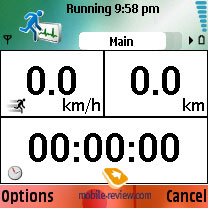
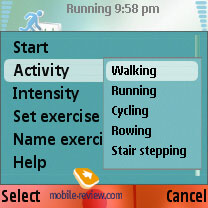
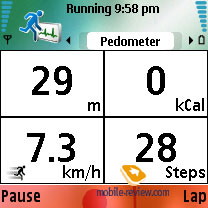
If you care, you can choose exercise type in extra settings, so
evaluation of calories burnt will be more precise. User may pick
one of the following activity types: walking, running, cycling,
rowing, stair stepping. Three traditionally intensity levels are
also on board. And finally you are at liberty to create your own
exercise with setting own goals (like calories burnt, distance covered,
exercise length).
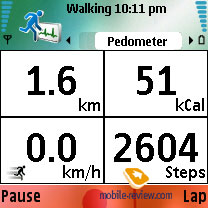
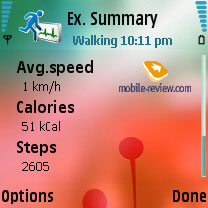
Completed exercises are saved to the Diary, where you see their
titles marked in special colors (greed spot – completed work-out,
blue – scheduled, red – missed). Basically such calendar is a perfect
method of planning all trainings are setting objectives for each
of them. Monthly and weekly views are available as well as list-appearance
of the schedule.
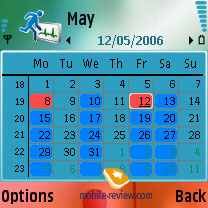
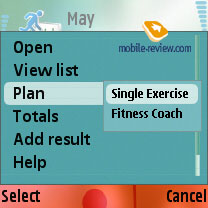
Those you go in for sports actively will find this system just
marvelous, as it allows tracking progress through-out months. The
company has even released Nokia Sport Manager for desktops, which
can accumulate all sport-related data from the handset, store it,
and perform some other functions. All in all the phones proves to
be a real power-house for exercises and load monitoring.

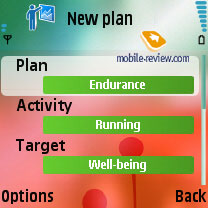
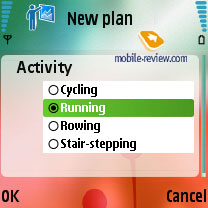
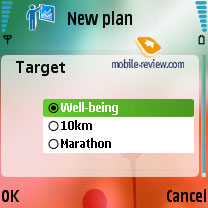
The settings menu holds fields for personal data such as sex, age,
height, weight, load level and pulse (normal and maximum). Even
though the handset doesn’t make use of pulse parameters at the moment,
I can make a guess that soon the model is going to obtain accessories
by Polar, similarly to Nokia 5140. And these let you see not only
pulse rate, but also blood pressure and a number of other useful
parameters.
In main settings you can define measuring system (metric, US, imperial)
as well as check whether backlight will turn off or work constantly.
During exercises this parameter is not so minor, in case you want
to check your status.
Memory status shows for how many trainings there’s space left,
usually that’s around 250-330 hours. Considering fact that data
goes straight into calendar, it isn’t few at all. With daily trainings
this will be enough for at least 6 months.
What I want to say briefly is that there are no similar products
like this one, Nokia’s product is a unique handset. Sony Ericsson
W710i can be used for more simple measurements, like for people
who walk a lot and need pedometer. At same time Nokia 5500 is a
more advanced tool for those who plan their trainings and look at
the progress. These are two different audiences of consumers, and
they do not cross.
Phone control
In case you are thinking that Nokia decided to add only steps counter
as usage of built-in sensor – you are wrong. Similarly to Samsung
E750 and E760, you can control several phone’s functions, but not
with moving the phone, tapping is done instead. When listening to
player, for example, you can tap twice on front panel in order to
pause it, or activate again. After you received an SMS – you can
tap in order the phone to open it. You can switch tracks by tapping
on the right or left side of the phone, depending on action you
want to perform. In training mode you can control functions too,
like start of new lap.
Presence of such control for player and sport mode is important
for those who are not able to be distracted during their trainings
for setting up their phone. Handset has been optimized for such
situations, and this is very interesting.
Video,
phone control (tapping) (wmv, 6.35 Mb)>>>
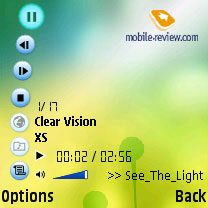
One of games installed has tap-support, it is called GrooveLab.
You control the ball in a labyrinth, a very interesting game, though
it will not be liked by everyone.

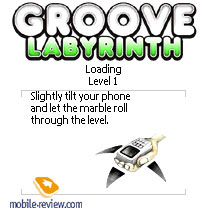
Text to Speech (TTS). Nokia is upgrading voice
functions in their platforms sequentially, both S40 and S60 receive
those updates. Latest generation of devices has voice dialing which
is not voice-dependant, the algorithm can also synthesize speech,
in this context this goes for a name stored in phone book. Synthesize
quality for different languages does not have any problems algorithm
is available for all languages supported by handset. It’s important
to highlight the fact that this algorithm works on S60 smartphones
as well as S40 models, such as Nokia 6230i.
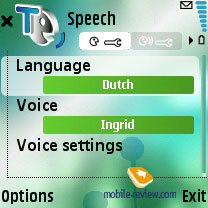
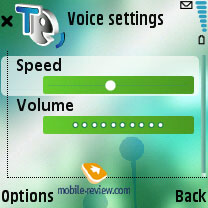
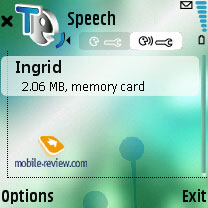
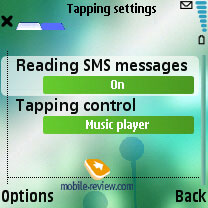
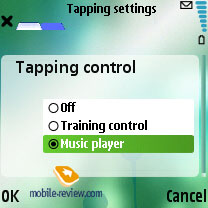
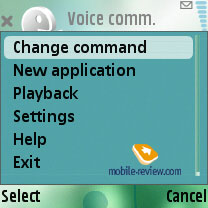
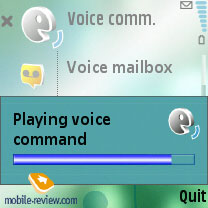
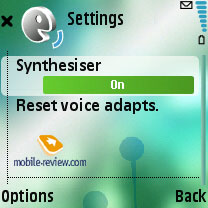
Basically Nokia’s research go into two big directions: Text To
Speech (which means transferring what was written into sound), and
Speech to Text which is basically reversible situation. A particular
case of Speech to Text is voice dialing which does not depend on
voice of user, and it does not require voice tags.
Unlike other manufacturers who prefer using 3rd party technologies
for voice actions and transferring text into speech, Nokia decided
to go their own way and develop the whole system themselves. Let
me remind you that most popular solutions come from VoiceSignal,
they are used in Motorola and Samsung handsets. Today several of
those phones have fully voice-controlled menu, ability to access
any function without preliminary voice training and so on. Of course
there’s also chance to announce all data that is viewed by user,
weather it’s SMS or memo in Organizer. Basically the system is combined
and offers both speech recognition and its synthesis. Nokia is not
trying to acquire leading position on the market at once, instead
it prefers to improve voice functions in its platforms step by step.
Unhurried development cycle creates impression that Nokia’s solution
is simplified and does not have any unique features. In my opinion
the company is only at beginning of its journey, and we should not
expect everything being presented at once. Considering the fact
that Nokia entered this race kind of late, we can say that its solutions
are successful, even though they are not as powerful as competitive
ones.
Another important aspect is positioning of devices. It’s a not
a secret to anyone that Nokia dominates smartphone market, its devices
have great market share. At the same time VoiceSignal’s solutions
are used mostly on simple phones, and they’re not so performance
hungry, it’s a good thing. Particular case is usage of VoiceSignal
on Linux-powered devices, this is what Motorola is doing (for Europe,
for take ROKR E2 for example). There are two different markets that
do not intersect with each other. Another special case are Windows
Mobile devices, here other solutions are used, and they’re optimized
for Microsoft’s products only, which seems logical.
In context of S60 solution dominance on market we can say about
lack of alternative solutions from Nokia today. We as users will
have to wait until company will fully integrate its product in all
current applications, and enrich their functionality. 3rd party
developments will not be able to integrate themselves with basic
functionality of S60 3rd edition, and its usage causes even more
questions. A curious fact is that Nokia 5500 is first device that
has preinstalled, integrated Text to Speech function. We can recall
communicator line-up, where such features were accessible with help
of 3rd party applications starting from Nokia 9200. But bigger interest
is presence of preinstalled packet from VoiceSignal is Nokia 6822.
This is an exception of rules made for American market, reason for
that is that voice features are in big demand and they are well-spread
too. Company is using flexible policy on markets where its share
is not so big, or it has to be aggressive. Another exception of
rules is presence of UIQ-communicator in Asia (ODM-product).
More information about VoiceSignal feature can be acquired by reading
links provided below, meanwhile we shall move on from theory to
practice of Text to Speech feature realization in Nokia 5500.
Voice
Signal realization in Motorola ROKR E2>>>
Comparing
voice dialing in Nokia N90 (standard edition) and VoiceSignal solution
(English)>>>
Nokia’s developers say that Text-To-Speech function can be implemented
into almost any standard application, it’s only a matter of expediency.
Nokia 5500 is mostly about sport part of phone, as result text to
speech function is present in two applications: for SMS messages
and in sport mode for standard application.
Once you receive an SMS you have 30 seconds to activate text to
speech function, you have to tap twice in order to do that, it does
not matter on which part of case you tap. Application that is used
for transferring text into speech will be launched automatically,
and you will be able to listen to message. In phone’ settings you
can disable automatic message reading via two taps, everything is
for your consideration. Greatest thing about realization of this
feature comes from the way this phone is positioned. When you are
doing your exercises, you are able to listen to music by wearing
headphones, and when you do that you might actually hear sound of
incoming message, and only thing you will have to do in order to
hear this message, is tap. This way you will not have to stop doing
your activities (bicycle, running, and so on). An elegant solution
that is ideal for focus group.


In main menu there’s Message Reader application which allows listening
to all messages starting from first and finishing with last. You
can also choose message that you are interested most in at the moment,
and it will be first one that application will read, and later on
go on with the rest, you can pause this activity at any time you
like.
Video,
Message Reader (wmv, 6.65 Mb)>>>

And it’s not only message that gets pronounced, there’s also sender’s
name. In case there’s no such entry in the phone book, you will
hear “Message from unrecognized number” phrase. System can pronounce
numbers quite nicely, and here this solution was probably ergonomics-based.
And it’s true, it is kind of hard to listen set of digits, you will
not memorize phone number, and in case you will, it will not do
any use either. A sort of simplification of sound interface in a
positive way.
In TTS settings you can select language in which this application
will work, a wise solution. A lot of users are using English as
their Menu language, at same time they prefer reading messages in
their native language. Other text recognition applications do not
have such settings, and they’re strictly attached to menu language,
this is definitely a disadvantage for them. Some Samsung products
are missing Russian voice pack, and as result there’s no voice dialing
at all.
Strongest aspects of algorithm are modular concept, this means
that its packets can be downloaded separately from main software.
There are several language packs shipped with standard package.
As a rule, files with voice packs are stored on memory card. Our
sample had following languages:
- Dutch, voice Ingrid
- English (UK), voice Ellen
- French, voice Marie
- German, voice Nicole
- Italian, voice Silvia
- Portuguese, voice Isabel
- Spanish, voice Lara
Each language pack is around 1.86mb big. As you have guessed, there
can be several voices for every language, for example, a male voice,
or female or childish (it’s not a trivial case for realization,
as it may seem at first sight). This means that user will be able
to choose the voice that will cast messages or exercises. A pretty
neat addition that makes TTS functionality even bigger. In case
Nokia will provide SDK to 3rd party manufacturers for voice profile
creation, there can appear a lot of them in short period of time,
as a result this will give a competitive advantage.
As for additional voice settings, you can select volume and speed.
Speed can be adjusted from 1 to 10, in this case 1 will be very
slow and 10 will remind you of a tongue-twister, as a result you
will not be able to comprehend it at all.
Sample
of various pronunciation speed for a message, ìð3-file, 508 Kb>>>
It’s not hard to understand that all extreme settings are not comfortable,
and their pretense is just a possible reserve for future. For example,
realization of pronunciation speed will be interesting in case speech
will remain comprehendible. In sound editors for desktop PCs this
algorithm is at place, and considering today’s processors in S60
smartphones, there are no barriers for this one being present here
too.
A little feedback for current system:
- Intellectual approach to pronouncing time in message body.
At the moment numbers are pronounced, not time in the way we are
used to. It’s not hard to define that it’s actually time in that
message, it usually has its own format and marker words (hour,
minute, and so on).
- Acronym dictionary for every language in SMS messages. Unfortunately,
system skips acronyms and spells letters separately, at same time
there are solutions on the market that have acronym dictionaries
and whenever there’s an acronym in a message, it will be spelled
in full version (like TBH – to be honest).
- Automatic language selection in message body and switch between
those.
- Emotions for several words and phrases, this makes speech more
natural.
After completing feedback list, I have unintentionally created
a plagiarism towards Loquendo
company, that has developed such system for Symbian OS (previous
S60 2nd edition phones). Unfortunately I was unable to find samples
of this system being used in the real world. That’s why we believe
that this still remains an internal development. But those items
and improvements are extremely important and acceptable for developers
in Nokia’s plans..
Sound playback quality in Nokia 5500, well, its synthesizing to
be precise, is typical for today’s systems in my opinion, I mean
it’s not very different from VoiceSignal’s solutions. Of course
synthesis quality is better than it was few years ago, it became
more human-like. According to feedback right here
, realization of interfaces in other languages is more human-like
than in English version. I shall not judge the quality on the whole,
for me it’s still too robotic, but it does not make you want to
turn it off at once, it’s pretty comfortable to listen to (this
goes for all solutions).
And this is how a message written in Russian but with English letters
sounds like (“Ya v metro, ne slishno”, which stands for “I am in
metro, can’t hear you”). Of course we have used Ellen’s voice as
well as Marie. I believe that you can clearly hear French accent,
and it’s possible to understand the text in both cases.
Sample
– message written in Russian but with Latin letters: English and
French samples, ìð3, 138 Kb>>>
Message
sample in Dutch, thanks to Mark for that one, ìð3, 84 Kb>>>
From practical moments I should also highlight the fact that usage
of TTS function in first place is possible with headset usage, you
will be able to hear speech via loudspeaker too, but it will not
be so good, even in relatively quite location. I won’t even start
talking about car, I mean you will not hear anything even if windows
are shut and sound isolation is at good level.
As for other applications where you can access voice commentaries,
I should probably tell you about sport mode, here you will be able
to hear your achievement, or new lap and stuff like that. On the
whole information is strongly predefined, and there’s no big need
in TTS, but its presence saves some resources.
In future we should expect TTS being used in standard applications,
a logical integration in web-browser, or at least for Web Feeds
section, which stands for RSS feeds (some samples already have it
though). TTS support in GPS section is important too, e-mail can
be added as well, and so on. I think that today we can see only
first steps that Nokia is making in that direction, and we’ll definitely
see more in future.
Camera
This handset has 2mpx CMOS camera, it is identical to one installed
in Nokia 3250, and it’s a good solution for average user.
Resolution – 1600x1200 pixels, 1152x864 and 640x480 pixels. The
picture’s quality can be one of these three: High, Normal and Baisc.
Shooting mode can be either normal, or a series of photos, you can
also setup timer (10, 20 or 30 seconds). Night mode is available
too. White balance can be setup by three options: Sunny, Incandescent,
Fluorescent. Color settings / SFX are standard: Sepia, Black&White,
Negative. There’s no LED (flash) in this phone. When you are in
the shooting mode digital zoom can be activated with joystick. There’s
no reason to use zoom, since you can scale the photo in the built-in
editor, and later on save it, the quality will be higher.
 |
 |
(+) maximize, 1600x1200, JPEG |
(+) maximize, 1600x1200, JPEG |
 |
 |
(+) maximize, 1600x1200, JPEG |
(+) maximize, 1600x1200, JPEG |
 |
 |
(+) maximize, 1600x1200, JPEG |
(+) maximize, 1600x1200, JPEG |
 |
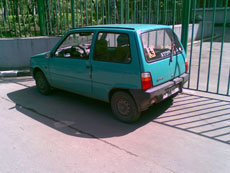 |
(+) maximize, 1600x1200, JPEG |
(+) maximize, 1600x1200, JPEG |
The video recording quality is mediocre, the only available resolutions
are 176x144 and 128x96 pixels at 15 frames per second. The recording
format is 3GP, you can disable sound if you like. There are no length
limitations, unless you setup MMS mode. I’d like to remind you that
this camera module is capable of 352x288 pixel video recording,
although the quality won’t be very good.
Sample
video (3GP, 244 Kb)>>>
Conclusion
The model does not have any problems with network reception quality,
the voice of interlocutor is clearly heard, as well as yours. The
volume of 64-tone polyphonic ring tone is high in case you use mp3
files. In this case the quality of polyphonic ring tones is not
so important. Vibrating alert’s power is below average, it cannot
be felt all the time.
Handset will be released in beginning of September and its price
will be around 300-330 euros. Considering filled bundling and its
unique status this price is more than justified. At the moment we
can define following unique points of this solution:
- Smallest S60 smartphone;
- Protective case, lack of competitors;
- Sportive applications, training diary, synchronization with
PC;
- Text to Speech supports different languages and can work with
SMS;
- Tap control, important in sport mode;
- Good preinstalled browser;
This list can go even further, but we should stop here. Nokia 5500
Sport is starting point for whole new line-up, it is interesting
too. Integration level for sport mode, phone’s design and erognomics
level are amazing, they deserve separate praise. It’s been a while
since we had a masterpiece at our hands, well-thought interface
and particular functions, their integration, the whole thing is
amazing. This phone is very neat looking and after two weeks you
feel sympathy towards it.
As a bonus for those who already acquired Nokia 3250, we should
tell you that Nokia 5500 has identical music part, although it is
not positioned as music solution. Same number of settings and other
minor things, as well as sound quality. I will highlight the fact
that since Nokia 5500 is not a music solution, it’s capabilities
are great, and this gives additional advantage.
In the end we have a perfect niche solution (this is not a mass-market,
just like any other phone with protective case), it does not have
direct competitors, and there’s little chance that any will appear
in nearest future. This model is extremely successful and deserves
special attention. This is one of the best smartphones in Nokia’s
and S60 history. In case the company will be able to provide same
level of integration for other niche products, we will see a rise
of those, and a horde of clones too, attempts to replicate Nokia’s
success. The way in which company is moving becomes clear now, these
are first successful products for S60. There’s only one disadvantage
for this product – battery life.
Description
of standard applications for Smartphone >>>
Browser description
>>>
Nokia 3250>>>
Eldar Murtazin (eldar@mobile-review.com)
Translated by Oleg Kononosov (oleg.kononosov@mobile-review.com)
Published — 25 May 2006
Have something to add?! Write us... eldar@mobile-review.com
|
News:
[ 31-07 16:21 ]Sir Jony Ive: Apple Isn't In It For The Money
[ 31-07 13:34 ]Video: Nokia Designer Interviews
[ 31-07 13:10 ]RIM To Layoff 3,000 More Employees
[ 30-07 20:59 ]Video: iPhone 5 Housing Shown Off
[ 30-07 19:12 ]Android Fortunes Decline In U.S.
[ 25-07 16:18 ]Why Apple Is Suing Samsung?
[ 25-07 15:53 ]A Few Choice Quotes About Apple ... By Samsung
[ 23-07 20:25 ]Russian iOS Hacker Calls It A Day
[ 23-07 17:40 ]Video: It's Still Not Out, But Galaxy Note 10.1 Gets An Ad
[ 19-07 19:10 ]Another Loss For Nokia: $1 Billion Down In Q2
[ 19-07 17:22 ]British Judge Orders Apple To Run Ads Saying Samsung Did Not Copy Them
[ 19-07 16:57 ]iPhone 5 To Feature Nano-SIM Cards
[ 18-07 14:20 ]What The iPad Could Have Looked Like ...
[ 18-07 13:25 ]App Store Hack Is Still Going Strong Despite Apple's Best Efforts
[ 13-07 12:34 ]Infographic: The (Hypothetical) Sale Of RIM
[ 13-07 11:10 ]Video: iPhone Hacker Makes In-App Purchases Free
[ 12-07 19:50 ]iPhone 5 Images Leak Again
[ 12-07 17:51 ]Android Takes 50%+ Of U.S. And Europe
[ 11-07 16:02 ]Apple Involved In 60% Of Patent Suits
[ 11-07 13:14 ]Video: Kindle Fire Gets A Jelly Bean
Subscribe
|


































































